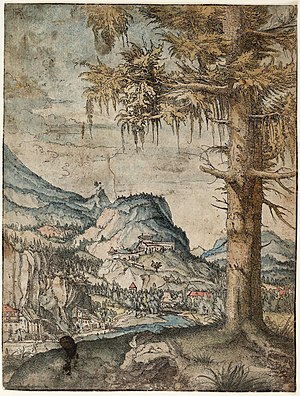Sulzeneck
| Sulzeneck | |
|---|---|
|
Sulzeneck Hallein Castle |
|
| Alternative name (s): | Sulzenegg |
| Creation time : | medieval |
| Castle type : | Hilltop castle |
| Conservation status: | Burgstall |
| Place: | Hallein |
The castle Sulzeneck (Sulzenegg) is an Outbound hilltop castle is part of the medieval fortification of Hallein in the province of Salzburg in Austria was.
The Veste Sulzeneck can be described as the castle of Hallein and lay above the city in the area of the forest on the eastern slopes of the Tuval . The inner border fortifications in the Middle Ages were the Vesten Schoßrisen ( Thürndl ruins ), Sulzeneck (Reckturm, Fuchsturm) and Hallburg ( Georgsberg 1262). The southern city wall ran from the Salzach, the Gollingertor at the city bridge, on the river bank to the Grieß Tor, on to the Gampertor, Hafnertor, on the Kotbach up to the Färbertor to the rocks below Sulzeneck Castle. Remnants of this city wall have been preserved to this day. Of the numerous city gates, only the Griessor is available. The Sulzeneck buildings were located in the area of the Riesengut directly above the city, to the west of the former "Eisinger's Gasthaus zur Gemse". The Reckturm, in the 14th century. known as the citizen's tower, and the fox tower, known as the “large iron gate”, were part of the medieval fortifications, which fell into disrepair at the beginning of the 19th century. The Fuchsturm has been preserved, the Reckturm (or Röckturm) was rebuilt and can be seen from the city.
"... the city wall ran ... to the foot of the Röckturm rock. Sulzeneck Castle was enthroned on the rock above the connection of the city wall to the steep demolition. ... The centerpiece of Sulzeneck Castle was a mighty tower on the highest Point of the ridge: After the citizens of Hallein took over the castle hat in the 14th century, the keep was called the "Bürgerturm". The name Röckturm or Reckturm referred to the torture chamber, which - like a dungeon - was housed in this tower. ... "
Description of the castle from a pen drawing - 1632
In the pictorial representation of Hallein from 1632, drawn by Johann Faistenauer from Berchtesgaden:
Above the Bannwald (“Bonholtz”), today's ruin, labeled “Schlössl”, has a high tower and a city-side barrier wall in front of it. To the right of it the Barmsteine ("Parmstain"). To the right above the old late Gothic parish church of St. Anthony ("S. Anthony") parts of the old Hallein city fortifications and the "Sulzeneck" castle, which are significantly larger than the current remains of the "Röckturm" visible from the valley.
Etching by Albrecht Altdorfer "The great spruce" - 1520
To the left of the spruce, the etching shows the view from Egglgut onto the Tuval mountain slopes above the town of Hallein with the Sulzeneck fortress. In the center of the fortification the Reckturm, a battlements-reinforced wall runs up to the Fuchsturm crowned by a pointed roof. Above the fortress of the ridges of the Bannwald, above the Riesengut, with the Kleiner Barmstein. From this perspective, the city is largely covered by trees.
Individual evidence
- ↑ Zillner, Dr. Franz, Valentin: On the history of the Salzburg salt system. Economic reviews and local history explanations. Salzburg 1879. pp. 1-64
- ^ Wagner, H. F: Topographie von Alt-Hallein in: MGSLK 55, 1915, pp. 1-44.
- ^ Moosleitner, Fritz: Hallein - Portrait of a small town. Hallein 1989. p. 96
- ^ Moosleitner, Fritz: Hallein. Portrait of a small town. Hallein 1989. pp. 97 f

